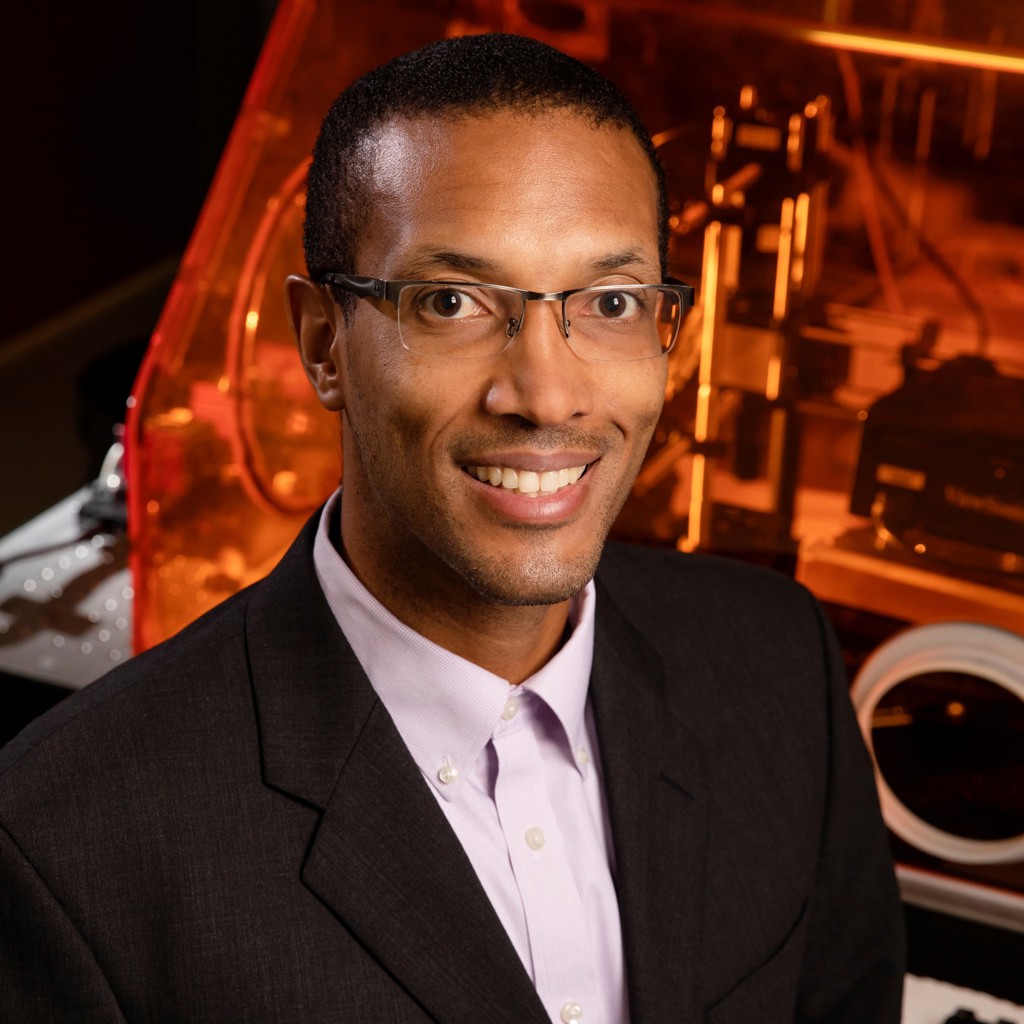Lynford Goddard
University of Illinois at Urbana-Champaign, USAFor contributions to the field of optical measurement science.

Surprisingly, Lynford Goddard became interested in physics as a result of his high school swimming career. An early project calculating the ideal diving angle gave him a practical problem to solve, and this triggered his initial interest in physics. Starting his undergraduate degree by taking many different classes in various fields, he found optics and lasers in his senior year. With that lab experience, he was hooked. His path was not a straight line, though. Lynford received a six-year fellowship from the National Physical Science Consortium sponsored by Xerox, which placed him at Xerox Palo Alto Research Center for his first two summers of graduate school. He also had a teaching assistantship at his school, Stanford University. With all of these important elements taking his time on top of required classwork, he was unable to find a lab until his third quarter. The lab he found was not interesting to him as he spent most of his time doing calculations. Sensing his disinterest in the work, the leader of the group let him go. After a successful summer at Xerox working with blue LEDs, Lynford returned to Stanford with a newfound interest in engineering and joined a group working on LISA (Laser Interferometer Space Antenna). The funding for this project was suddenly cut a year and half later, leaving Lynford projectless once more. With this second set back, Lynford was concerned that he may not be able to finish his PhD, and turned to his network of past advisors to help. His undergraduate advisor Douglas Osheroff put him in contact with Jim Harris, who turned out to be a perfect fit, and Lynford completed his studies in that lab. There he was able to work on the dilute nitrides, a new material system that had interesting optical properties, which united his physics interest and engineering experience working at Xerox. He uses his own story to help and inspire his students today, saying, “a lot of us see the successful stories…but haven’t really understood that it’s not a straight path.”
Now a group leader himself at the University of Illinois at Urbana-Champaign, Lynford emphasizes collaboration. He has a wide range of interests, and collaborations allow him to explore them all. With his colleagues, he has worked on many projects, including carbon dioxide sensors for corn silos that alert farmers to corn decomposition, hydrogen detection to see how hydrogen is released in industrial field processes, working with computer science colleagues on high performance and heterogeneous computing, and many more. He comments, “Being able to do these sorts of interdisciplinary collaborations where we’re utilizing cutting-edge technology to solve problems in the optics and photonics fields has been very rewarding.” He goes on to say, “it’s just being able to take the expertise that I have, and the students in my group have, and finding people who are interested in applying it to different types of problems.” In fact, Lynford attributes much of his success in his career to his students and his collaborators.
As a dedicated mentor, Lynford has a wealth of great advice for young scientists. When deciding what path to take, he advises “think about what matters to you and why it matters…Understand why you’re doing what you’re doing.” If your work has no impact, it will not be fulfilling. He also suggests “be prepared to fail, and be excited when you fail…when things don’t work, that’s where you have an opportunity to learn and to challenge your current understanding of the problem.” He says that failing 20% of the time is the sweet spot because it confirms that you are pushing the boundaries of what is known. Lynford also suggests that failure does not mean that the project was a waste: “sometimes when things don’t work, you can turn that bug into a feature.” He loves working with his students as they attempt to understand their findings, encouraging them to take this advice. His favorite part of the research process is interacting with his students and collaborators, comparing what was known with what the experiment reveals. Not only can the experiment reveal discrepancies, but also opportunities.
Looking to the future, Lynford thinks that this is the best time to be active in optics. “It’s a field that’s growing, that there are opportunities for people to go into as a career that are very strong, that are interesting, that have important impact to society….We’re able to experience the ability for collaborations to exist worldwide, but then there’s also the base knowledge that has existed for decades to centuries that allows us to do the research that we’re able to do. I’m just really excited about the future that optics and photonics can give for our nation and for the world.”
Photo Credit: UI News Bureau: L. Brian Stauffer
Profile written by Samantha Hornback
